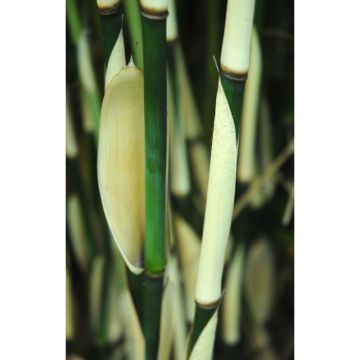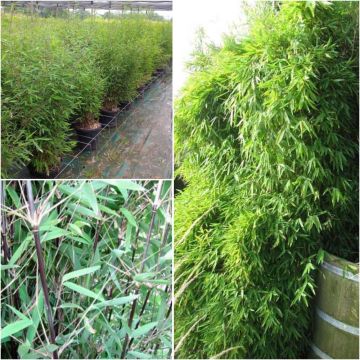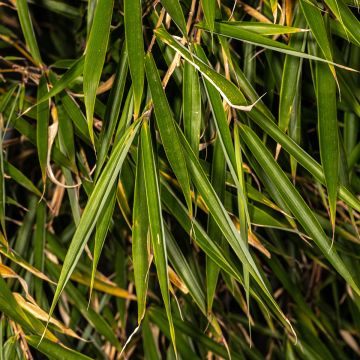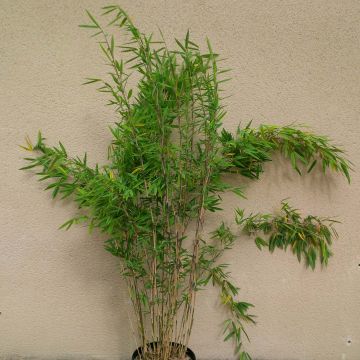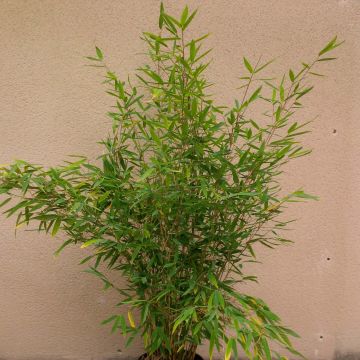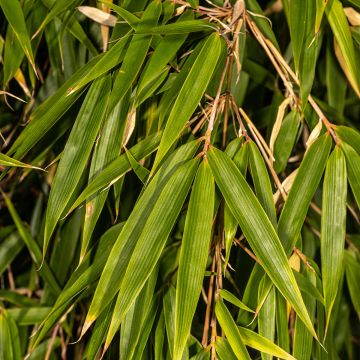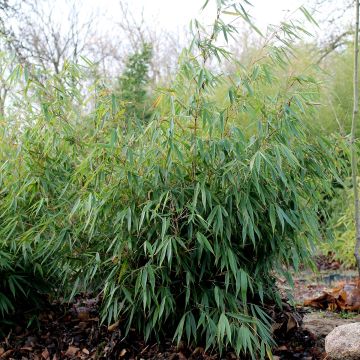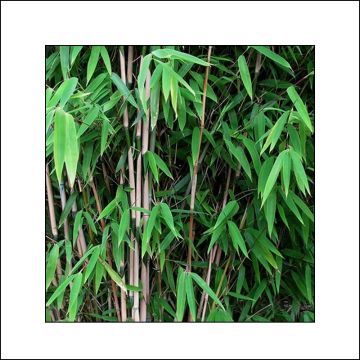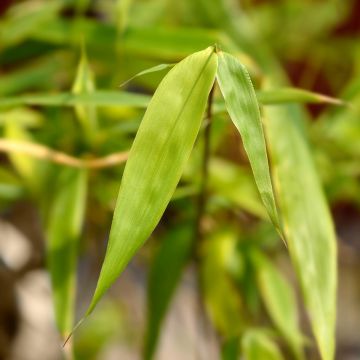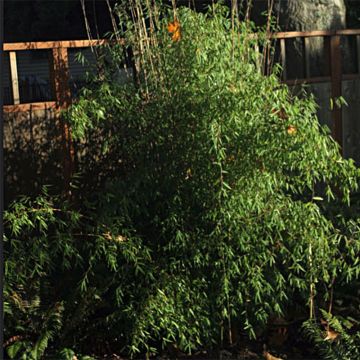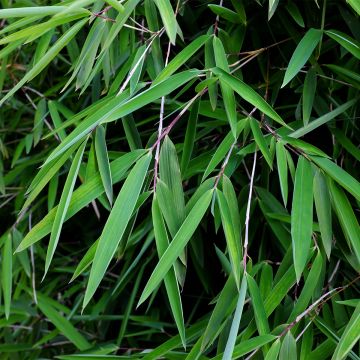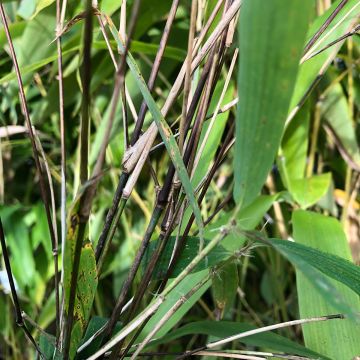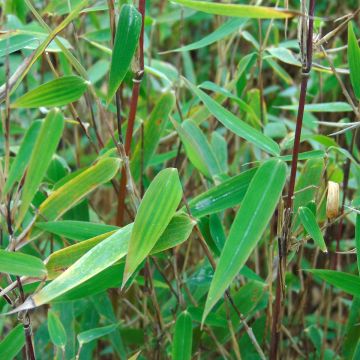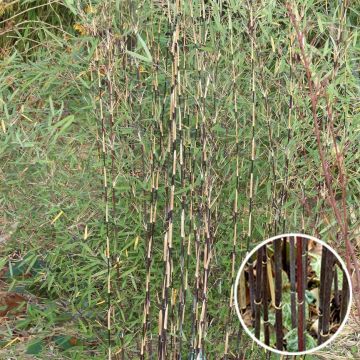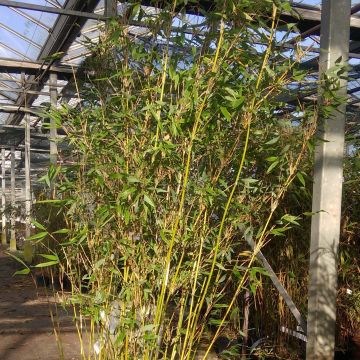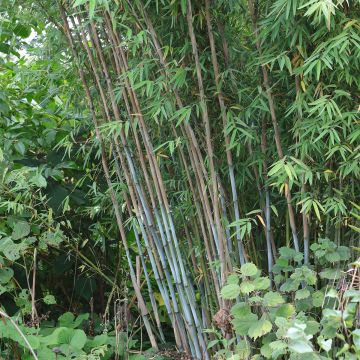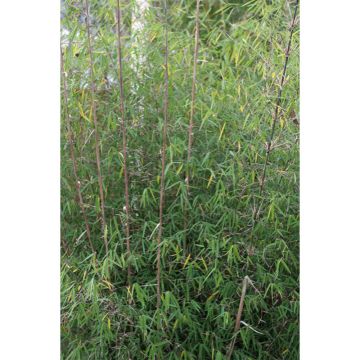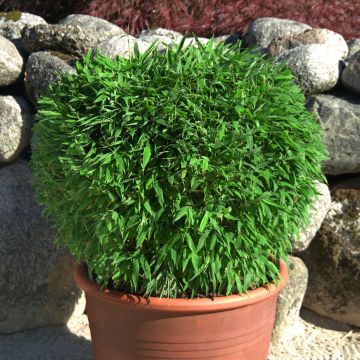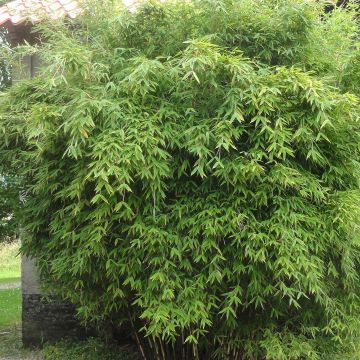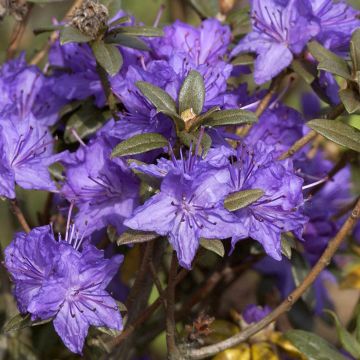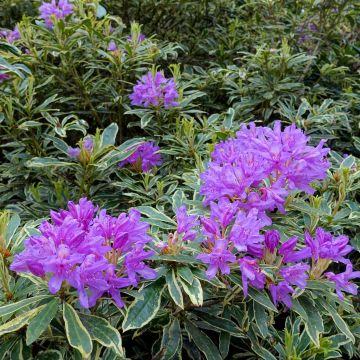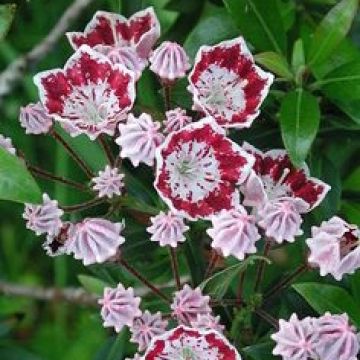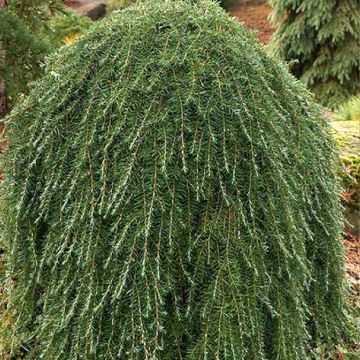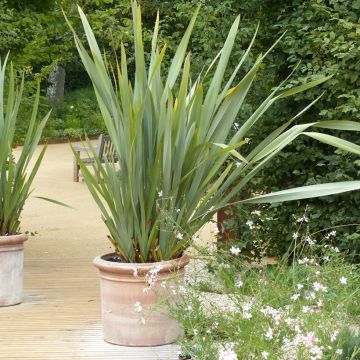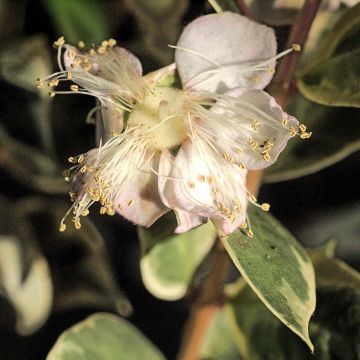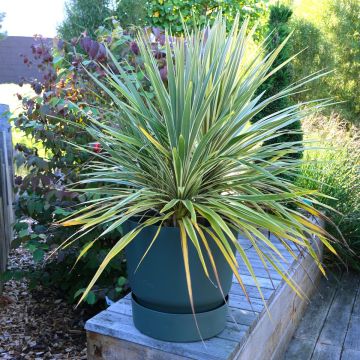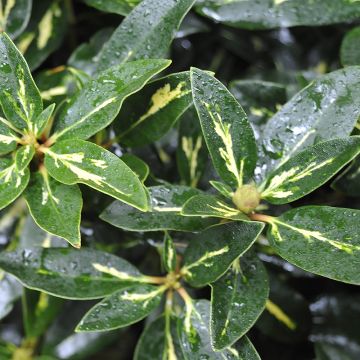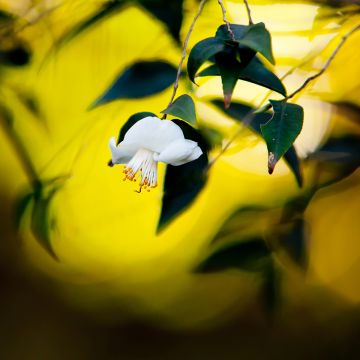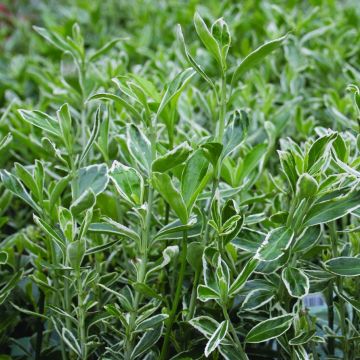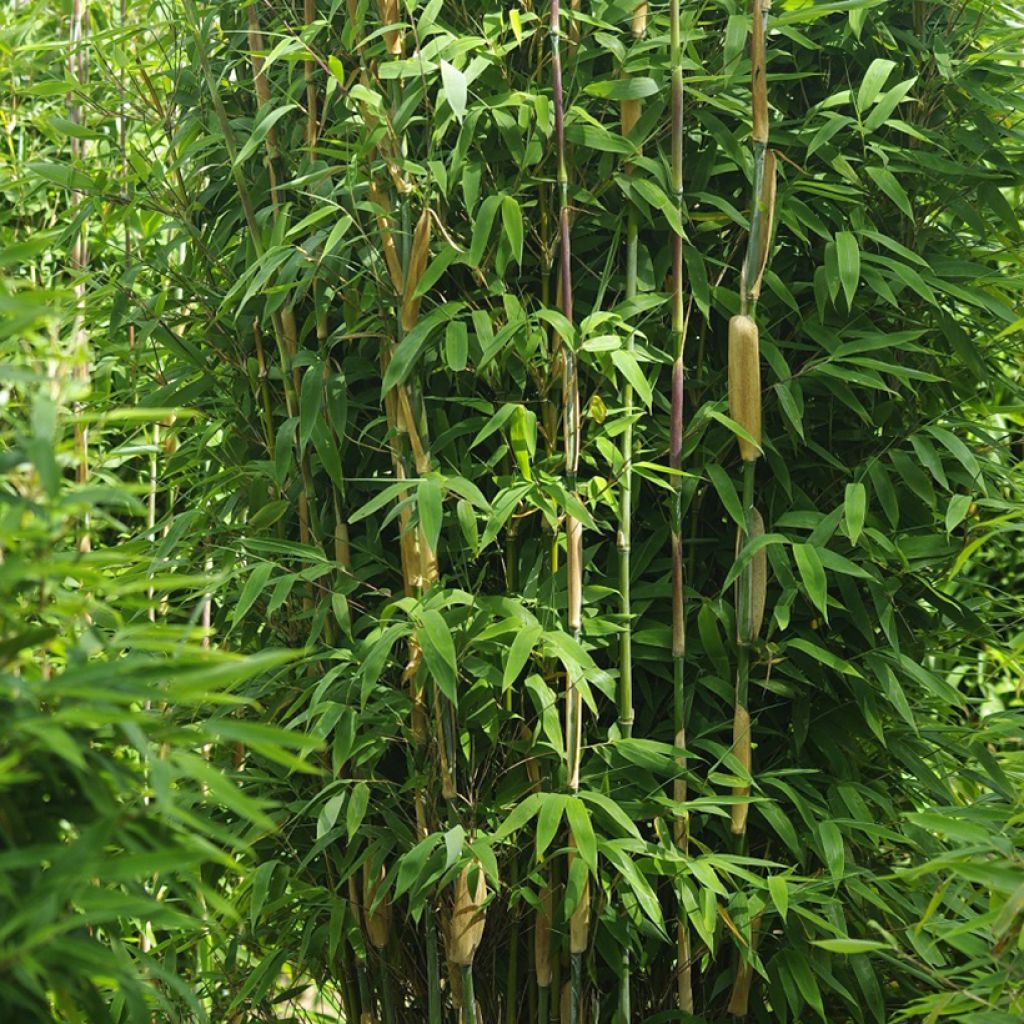

Fargesia murielae Maasai - Non-running bamboo
Fargesia murielae Maasai - Non-running bamboo
Fargesia murielae Maasai ®
Why not try an alternative variety in stock?
View all →This plant carries a 24 months recovery warranty
More information
We guarantee the quality of our plants for a full growing cycle, and will replace at our expense any plant that fails to recover under normal climatic and planting conditions.
Oversize package: home delivery by special carrier from €6.90 per order..
Express home delivery from €8.90.
Does this plant fit my garden?
Set up your Plantfit profile →
Description
Fargesia murielae Maasai is a non-running bamboo that can be used as a standalone plant or in a container but is especially ideal for forming a dense and decorative hedge. It grows quickly and has an upright habit, quickly forming a dense and opaque green screen. It is appreciated for its decorative green canes, mostly covered by white leaf sheaths. It is highly resistant to cold and can thrive in any good garden soil, preferably neutral to acidic, but also tolerates limestone, making it adaptable to many regions. This non-invasive bamboo can be planted in small gardens or containers.
Fargesia murielae belongs to the Poaceae family, formerly known as Gramineae. It produces woody canes that grow from a non-running rhizomatous rootstock, known as clump-forming. In this type of bamboo, the short internode rhizomes slowly develop at the periphery of the rootstock, gradually widening it, but they also grow towards the centre of the clump, keeping it dense without thinning out from the middle. Another great advantage is that it won't risk being invaded by rhizome shoots at a distance from the main clump.
This cultivar 'Maasai' is a recent horticultural variety from the Well Born Bamboo Africa range, obtained through sowing and selection of the best specimens. This bamboo has very distinct characteristics, the most noticeable being its almost columnar habit, especially in the first years. It grows quickly, even very quickly under optimal conditions (up to 1m per year), reaching its adult height of about 3.50m rapidly, while the clump formed can measure less than a metre in diameter (gradually widening over the years). The green canes, sometimes slightly bluish as they age, are slender and measure approximately 2cm in diameter. They bear numerous green leaves, about 10cm long and 2.5cm wide. In situations of stress, drought or cold, the leaves tend to roll inwards along their length, but then return to their normal shape. The lateral shoots are relatively short, and the leaves tend to broaden slightly after pruning, which does not detract from its ornamental character. In this variety, the whitish leaf sheaths cover a good part of the culms, contrasting well.
Another quality of Maasai is its particularly developed cold resistance, as it can withstand temperatures as low as -25°C and even -28°C.
This bamboo grows in most soils, from moist to wet, but not waterlogged. It prefers neutral to acidic soils but shows some tolerance to limestone. A rich soil will promote its growth, as well as a sunny to semi-shaded exposure. It also tolerates shade, but its growth will be reduced, and its habit will widen. Well-suited to pruning, it will create beautiful dense hedges and can also be planted in containers, controlling its height with shears.
Fargesia murielae Maasai, with its dense canes and foliage, evergreen and fast-growing, is perfect for creating a decorative or protective hedge. It withstands wind well and forms a completely opaque screen of vegetation. Its architectural appearance can be exploited in contemporary settings and to create an exotic-inspired atmosphere even in cold climates. When planted as a hedge, it forms a dense green screen that will showcase the plants at its base. Avoid plants with thin green leaves that visually blend with Maasai, and instead opt for colourful, purple or golden foliage and large leaves. For example, Magnolia tripetala, a small tree with leaves that can reach 60cm long, will create an original scene, especially as it is relatively unknown. Another lesser-known gem, Ptelea trifoliata Aurea, is a small Samaria Elm with golden, finely cut foliage that will stand out against the green curtain of your hedge. In mild climates, Phormium tenax Purpureum, a New Zealand Flax with long, ribbon-like purple leaves, will enhance the sculptural effect of your composition.
Report an error about the product description
Plant habit
Foliage
Botanical data
Fargesia
murielae
Maasai ®
Poaceae
Cultivar or hybrid
Other Fargesia
Planting and care
Fargesia murielae Maasai tolerates all exposures, from sunny to shady, including partial shade. Plant this bamboo in a rich soil that remains slightly moist in summer, rather heavy and retains water well (as a guide, the adult plant requires about 20 litres of water per week in hot weather and 10 litres the rest of the year). This Fargesia will grow in neutral or slightly acidic soil, and will even tolerate some limestone. If necessary, replace the soil in your garden with good potting soil, especially if your soil is very sandy and well-draining. Plant in spring or autumn, and for creating a hedge, plant one every 60 cm to obtain a dense green curtain.
In a pot, monitor watering, especially when the foliage is very abundant, and from early March to mid-April, apply 2 handfuls of lawn fertilizer at the base of your non-invasive bamboo. Its foliage will be greener. This bamboo tolerates pruning very well, so its height can easily be controlled with shears to maintain its growth if planted in a container.
Like all other Fargesia, this non-invasive bamboo does not require a rhizome barrier. However, keep in mind that non-invasive does not mean it will not spread over the years. The plant will indeed grow, but gradually, without emitting long rhizomes that would shoot out a few metres away. It keeps its green foliage throughout the winter and loses some leaves throughout the year, more so in late autumn. These accumulate at the base of the canes, forming a protective mulch against soil dehydration, which is best left in place. In hot climates, it is also useful to mulch the soil to maintain some moisture at the roots.
Planting period
Intended location
Care
This item has not been reviewed yet - be the first to leave a review about it.
Evergreen shrubs
Haven't found what you were looking for?
Hardiness is the lowest winter temperature a plant can endure without suffering serious damage or even dying. However, hardiness is affected by location (a sheltered area, such as a patio), protection (winter cover) and soil type (hardiness is improved by well-drained soil).

Photo Sharing Terms & Conditions
In order to encourage gardeners to interact and share their experiences, Promesse de fleurs offers various media enabling content to be uploaded onto its Site - in particular via the ‘Photo sharing’ module.
The User agrees to refrain from:
- Posting any content that is illegal, prejudicial, insulting, racist, inciteful to hatred, revisionist, contrary to public decency, that infringes on privacy or on the privacy rights of third parties, in particular the publicity rights of persons and goods, intellectual property rights, or the right to privacy.
- Submitting content on behalf of a third party;
- Impersonate the identity of a third party and/or publish any personal information about a third party;
In general, the User undertakes to refrain from any unethical behaviour.
All Content (in particular text, comments, files, images, photos, videos, creative works, etc.), which may be subject to property or intellectual property rights, image or other private rights, shall remain the property of the User, subject to the limited rights granted by the terms of the licence granted by Promesse de fleurs as stated below. Users are at liberty to publish or not to publish such Content on the Site, notably via the ‘Photo Sharing’ facility, and accept that this Content shall be made public and freely accessible, notably on the Internet.
Users further acknowledge, undertake to have ,and guarantee that they hold all necessary rights and permissions to publish such material on the Site, in particular with regard to the legislation in force pertaining to any privacy, property, intellectual property, image, or contractual rights, or rights of any other nature. By publishing such Content on the Site, Users acknowledge accepting full liability as publishers of the Content within the meaning of the law, and grant Promesse de fleurs, free of charge, an inclusive, worldwide licence for the said Content for the entire duration of its publication, including all reproduction, representation, up/downloading, displaying, performing, transmission, and storage rights.
Users also grant permission for their name to be linked to the Content and accept that this link may not always be made available.
By engaging in posting material, Users consent to their Content becoming automatically accessible on the Internet, in particular on other sites and/or blogs and/or web pages of the Promesse de fleurs site, including in particular social pages and the Promesse de fleurs catalogue.
Users may secure the removal of entrusted content free of charge by issuing a simple request via our contact form.
The flowering period indicated on our website applies to countries and regions located in USDA zone 8 (France, the United Kingdom, Ireland, the Netherlands, etc.)
It will vary according to where you live:
- In zones 9 to 10 (Italy, Spain, Greece, etc.), flowering will occur about 2 to 4 weeks earlier.
- In zones 6 to 7 (Germany, Poland, Slovenia, and lower mountainous regions), flowering will be delayed by 2 to 3 weeks.
- In zone 5 (Central Europe, Scandinavia), blooming will be delayed by 3 to 5 weeks.
In temperate climates, pruning of spring-flowering shrubs (forsythia, spireas, etc.) should be done just after flowering.
Pruning of summer-flowering shrubs (Indian Lilac, Perovskia, etc.) can be done in winter or spring.
In cold regions as well as with frost-sensitive plants, avoid pruning too early when severe frosts may still occur.
The planting period indicated on our website applies to countries and regions located in USDA zone 8 (France, United Kingdom, Ireland, Netherlands).
It will vary according to where you live:
- In Mediterranean zones (Marseille, Madrid, Milan, etc.), autumn and winter are the best planting periods.
- In continental zones (Strasbourg, Munich, Vienna, etc.), delay planting by 2 to 3 weeks in spring and bring it forward by 2 to 4 weeks in autumn.
- In mountainous regions (the Alps, Pyrenees, Carpathians, etc.), it is best to plant in late spring (May-June) or late summer (August-September).
The harvesting period indicated on our website applies to countries and regions in USDA zone 8 (France, England, Ireland, the Netherlands).
In colder areas (Scandinavia, Poland, Austria...) fruit and vegetable harvests are likely to be delayed by 3-4 weeks.
In warmer areas (Italy, Spain, Greece, etc.), harvesting will probably take place earlier, depending on weather conditions.
The sowing periods indicated on our website apply to countries and regions within USDA Zone 8 (France, UK, Ireland, Netherlands).
In colder areas (Scandinavia, Poland, Austria...), delay any outdoor sowing by 3-4 weeks, or sow under glass.
In warmer climes (Italy, Spain, Greece, etc.), bring outdoor sowing forward by a few weeks.

































